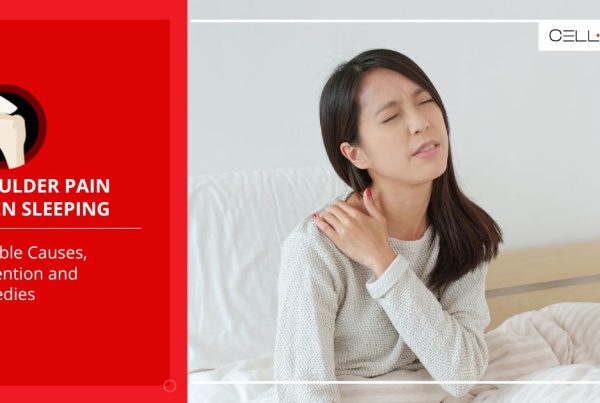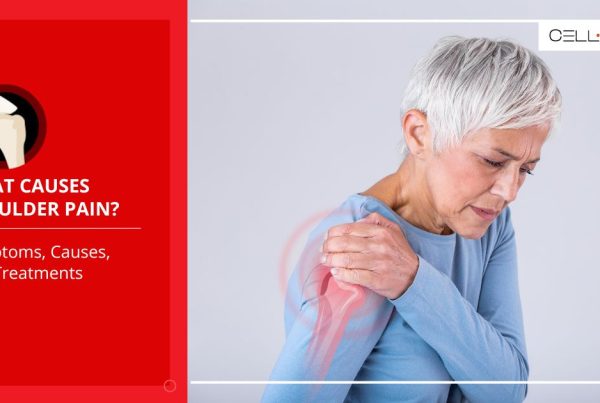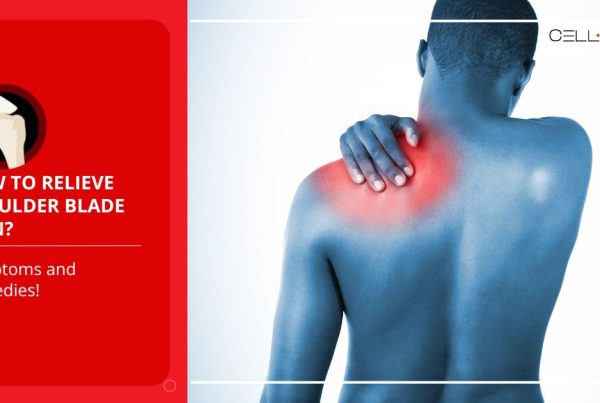Published on: December 9, 2024 | Updated on: January 18, 2025
The shoulder connects our upper arms to the body through three bones: the upper arm bone, called the humerus; the shoulder blade called the scapula; and the collarbone, called the clavicle.
The three attached muscle groups on the scapulae — the rhomboids and the middle and lower trapezius enable shoulder movements together with the help of four shoulder joints, making our shoulder the most mobile joint in the body.
Any stress or injury to the shoulder blade, joint, or attached muscles causes cramps, muscular strain, or ligament sprain.
On top of this, bad posture with hunched shoulders makes things worse for our shoulder joints, causing pain. It’s crucial to know how to fix shoulder pain to relieve muscle tension cramps, and restore our range of motion.
Types of Shoulder Pain
The lifetime shoulder pain prevalence ranges from 6.9% to 67%. This means that up to 67% of people experience shoulder pain at some point during their lives.
The shoulder comprises the four joints, attached muscle groups, tendons, and ligaments. The attached muscles with the tendons—also called rotator cuffs, enable movement. The ligaments and cartilage stabilize the shoulders.
Injury, trauma, or strain to any of these structures in the shoulder causes pain. The most common cause of shoulder pain is due to an injury to the shoulder capsule. The mechanical pain resulting from this affects other associated structures, causing intense pain that restricts the movement of the shoulder.
Other types of shoulder pain include chronic pain resulting from rotator cuff tear, joint dislocation, bursitis, or acute pain from frozen shoulder, inflammation, arthritis, etc.
Symptoms of Shoulder Pain
Some common symptoms of shoulder pain include the following.
- Shoulder tenderness
- Sharp radiating pain to the arm
- Limited range of motion
- Tingling sensation
- Weakness in the shoulder and arms
- Difficulty rolling the shoulders
- Shoulder stiffness
- Dull aching pain
- Muscle spasms
- Swelling and redness
- Drooped posture
How to Fix Shoulder Pain?
Sitting in the same position with a bad posture with hunched shoulders, forward head tilt, and rounded arms causes shoulder pain and muscular stiffness.
Improperly lifting heavy objects also puts a strain on the muscles of the back and shoulders, making them sore. It is quite difficult to carry out everyday activities with shoulder pain.
As our shoulder is the most mobile joint in the body, its range of motion allows us to do everyday tasks such as reaching for objects, combing our hair, or brushing our teeth. Restricted movement leaves one wondering how to fix shoulder pain to restore the range of motion.
There are several home remedies you can try to prevent and fix shoulder pain if it results from muscular stiffness or injury. Here are some ways to fix shoulder pain and relieve discomfort.
1. Reduce Postural Stress
Sitting in front of a monitor, using a desk for hours, and improper body mechanics when working out at the gym are a leading cause of shoulder pain. Adjusting your posture relieves shoulder pain as the muscles don’t have to hold your arm and shoulder weight in an unnatural position.
If you want to know how to fix shoulder pain resulting from sprains and strains, here are some postural adjustments. Don’t hunch your shoulders when you’re sitting in front of a desk.
If you use a monitor or laptop for hours, avoid the forward head tilt as it puts pressure around your shoulders, which causes pain. If your work requires a workstation, take regular breaks to stretch out the arms over the head.
You should also make small ergonomic changes, such as using a back brace to avoid slouching or leaning forward while working.
When you sit for hours, make sure to straighten your back to keep the spine aligned. This reduces the pressure from the shoulders, relieving pain.
2. Gentle Exercises
Experiencing acute shoulder pain? Knowing how to fix shoulder pain through gentle exercises not only reduces muscular tension and pain but also increases flexibility.
Start with shoulder rolls to bounce off shoulder pain due to stiffness. Rolling the shoulders forward and backward in circular motions relieves the pressure on the shoulder capsule.
Besides this, you can cross one arm over the chest and pull it closer with the alternate hand to stretch the shoulders.
These gentle exercises relieve shoulder pain by reducing stiffness, building strength, and loosening the tight muscles.
3. Ice and Heat Therapy
Sometimes, shoulder pain does not result from bad sleeping positions or stiffness. Underlying causes such as rotator cuff tears or bursitis cause shoulder pain.
Knowing how to fix shoulder pain that results from a recent injury or medical condition can help you better manage your condition.
It is recommended that you ice the area for immediate pain relief. Icing narrows the blood vessels in the shoulders, reducing swelling and pain.
Use an ice pack over the affected area for 15 to 20 minutes every three to four hours. Never place the ice directly onto the skin; instead, wrap it in a cloth or towel to prevent frostbite.
If the shoulder pain results from muscle tension, use a hot water bottle or a warm compress. Heat increases the blood flow to the area, which reduces muscle tension and allows the shoulder muscles to relax. This helps reduce the pain that you experience due to frozen shoulders, muscle spasms, strains, and sprains.
4. Take a Break From Strenuous Activities
You should immediately hold off on strenuous activities until you recover completely. If your shoulder hurts, you should never continue weightlifting, resistance training, or play sports that put a strain on the shoulder.
These activities worsen the pain. If you continue with such activities, they can rupture the tendons or result in pulled ligaments.
Avoid all such activities for 24 to 48 hours, as the pain could be the result of repetitive strain injury. Resting and allowing the body to heal is important for restoring shoulder function and range of motion.
5. Massage Therapy
An involuntary contraction of the shoulder muscles can cause shoulder pain. If the pain in your shoulders feels like a tight knot, you should consider massage therapy.
Massage therapy relieves pain as it improves the blood flow to the area. Improved blood flow reduces the tightness in your muscles, which relieves pain. You can try some self-massage techniques to fix shoulder pain.
Use a foam roller or a massage ball over the shoulders to relieve muscle tension. You can also consider physical therapy, which works well to fix shoulder pain. It focuses on muscle strengthening and low-impact exercises that reduce stiffness and pain.
Wrap Up
The most common types of shoulder pain resulting from sprains or strains are effectively managed at home. Use massage therapy, ice and heat therapy, gentle exercises, and postural adjustments to fix shoulder pain.
However, if these home remedies fail to work, it’s wise to consult a healthcare provider. You can also consult a physical therapist or a general physician to devise a treatment strategy that addresses the pain and prevents it from getting worse.
Sources
Footnotes
- Kato K, Watanabe A, Hirayama J, et al. Shoulder pain has most impact on poor quality of life among various types of musculoskeletal pain in middle-aged and elderly people: Yakumo study. Mod Rheumatol. 2019;30(4):1-15.
- Hodgetts CJ, Leboeuf-Yde C, Beynon A, Walker BF. Shoulder pain prevalence by age and within occupational groups: a systematic review. Arch Physiother. 2021;11:24.
- Susilowati IH, Kurniawidjaja LM, Nugraha S, Nasri SM, Pujiriani I, Hasiholan BP. The prevalence of bad posture and musculoskeletal symptoms originating from the use of gadgets as an impact of the work from home program of the university community. Heliyon. 2022;8(10).
- Malanga GA, Yan N, Stark J. Mechanisms and efficacy of heat and cold therapies for musculoskeletal injury. Postgrad Med. 2015 Jan;127(1):57-65.
- Golshani K, Cinque ME, O’Halloran P, Softness K, Keeling L, Macdonell JR. Upper extremity weightlifting injuries: Diagnosis and management. J Orthop. 2018 Mar;15(1):24-27.
- Weerapong P, Hume PA, Kolt GS. The mechanisms of massage and effects on performance, muscle recovery and injury prevention. Sports Med. 2005;35(3):235-56.
References
- Anatomy, Shoulder and Upper Limb, Shoulder. StatPearls. Accessed 09/18/2024.
- Shoulder Pain in Adults. Mayo Clinic. Accessed 09/18/2024.
- Poor Posture Can Cause Shoulder Pain. Mayo Clinic Health System. Accessed 09/18/2024.
- Injuries & Pain: When to Use Ice or Heat. UnityPoint Health. Accessed 09/18/2024.
- Ruptured Tendon. WebMD. Accessed 09/18/2024.
- Shoulder Impingement Syndrome. NHS. Accessed 09/18/2024.
- What to Know About Muscle Knots. WebMD. Accessed 09/18/2024.
CELLAXYS does not offer Stem Cell Therapy as a cure for any medical condition. No statements or treatments presented by Cellaxys have been evaluated or approved by the Food and Drug Administration (FDA). This site contains no medical advice. All statements and opinions are provided for educational and informational purposes only.
Dr Pejman Bady
Author
Dr. Pejman Bady began his career over 20 years ago in Family/Emergency Medicine, working in fast-paced emergency departments in Nevada and Kansas. He has served the people of Las Vegas as a physician for over two decades. Throughout this time, he has been met with much acclaim and is now the head of Emergency Medical Services in Nye County, Nevada. More about the doctor on this page.
Dr Pouya Mohajer
Contributor
Pouya Mohajer, M.D. is the Director of Spine and Interventional Medicine for CELLAXYS: Age, Regenerative, and Interventional Medicine Centers. He has over 20 years of experience in pain management, perioperative medicine, and anesthesiology. Dr. Mohajer founded and is the Medical Director of Southern Nevada Pain Specialists and PRIMMED Clinics. He has dedicated his career to surgical innovation and scientific advancement. More about the doctor on this page.









